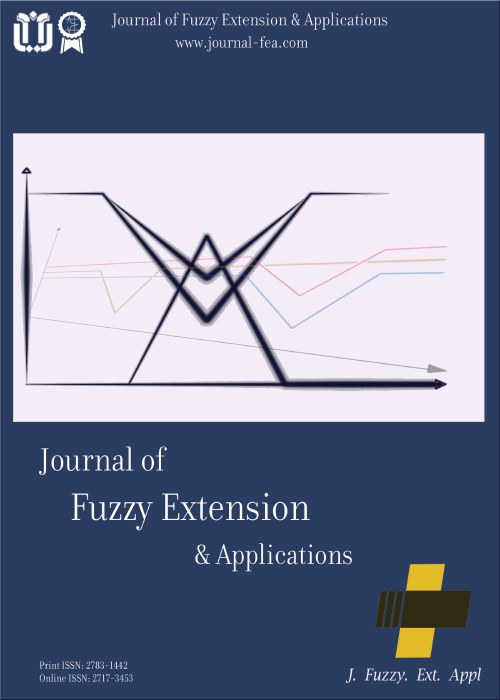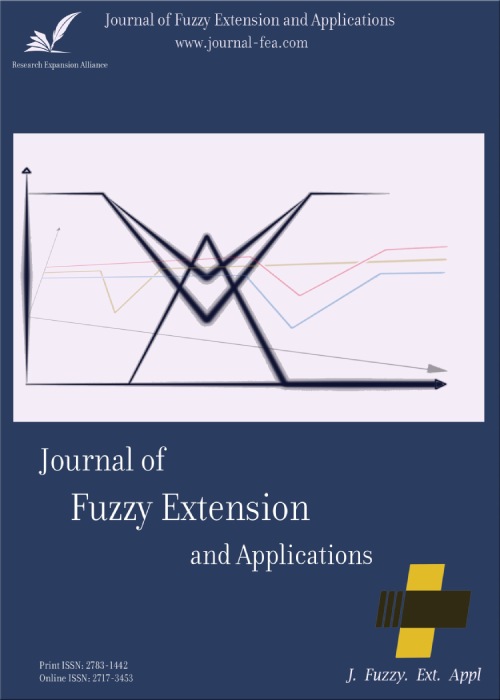فهرست مطالب

Journal of Fuzzy Extension and Applications
Volume:4 Issue: 1, Winter 2023
- تاریخ انتشار: 1401/12/10
- تعداد عناوین: 7
-
-
Pages 1-7
The term fuzzy logic is generic as it can be used to describe the likes of fuzzy arithmetic, fuzzy mathematical programming, fuzzy topology, fuzzy graph theory ad fuzzy data analysis which are customarily called fuzzy set theory. The aspect of pure Mathematics has undergone a lot of dynamic developments over the years. Since inception , the study has been extended to some other important classes of finite abelian and nonabelian groups such as the dihedral , quaternion, semidihedral, and hamiltonian groups. Other different approaches have been so far, applied for the classification. Every finite p-group is nilpotent. The nilpotence property is an hereditary one. Thus, every finite p-group possesses certain remarkable characteristics. Efforts are carefully being intensified to calculate , in this paper, the explicit formulae for the number of distinct fuzzy subgroups of the Cartesian product of the dihedral group of order 25 with a cyclic group of order of an n power of two for, which n ≥ 5.
Keywords: finite p-groups, nilpotent group, Fuzzy subgroups, Dihedral group, Inclusion-Exclusion Principle, maximal subgroups -
Pages 8-17Sambathkumar introduces the notion of global domination in graphs. According to him, a dominating set S of G is a global dominating set of G if S is also a dominating set of the complement of G.Nagoorgani and Jahir Hussain introduced the concept of global domination infuzzy graphs using effective arcs. This paper presents global domination infuzzy graphs using strong arcs. The strong global domination number of different classes of fuzzy graphs is obtained. An upper bound for the strong globaldomination number of fuzzy graphs is obtained. Strong global domination infuzzy trees is studied. It is established that every node of a strong global dominating set of a fuzzy tree is either a fuzzy cut node or a fuzzy end node. Itis proved that in a fuzzy tree each node of a strong global dominating set isincident on a fuzzy bridge. Also, the characteristic properties of the existenceof a strong global dominating set for a fuzzy graph and its complement areestablishedKeywords: the weight of arcs, strong domination, strong global domination
-
Pages 18-27This paper, considers the fuzzy topological subsets, fuzzy topological spaces and introduces a novel concept of fuzzy Hausdorff space and fuzzy manifold space in this regards. Based on these concepts, we present a concept of fuzzy metric Hausdorff spaces and fuzzy metric manifold spaces via the notations of KM-fuzzy metric spaces.This study, generalises the concept of fuzzy metric space to union and product of fuzzy metric spaces in classical logic and in this regard investigates the some product of fuzzy metric fuzzy manifold spaces. We apply the notation of valued-level subsets and make a relation between of topological space, Husdorff space, manifold space and fuzzy topological space, fuzzy Husdorff space and fuzzy manifold space. In final, we extended the fuzzy topological space, fuzzy Husdorff space and fuzzy manifold space to fuzzy metric topological space, fuzzy metric Husdorff space and fuzzy metric manifold spaceIndeed, this study analyses the notation of fuzzy metric manifold based on valued-level subset.Keywords: Fuzzy metric space, t-norm, fuzzy (metric)Hausdorff space, fuzzy (metric)manifold space
-
Pages 28-39Multiple criteria decision analysis (MCDA) has been widelyinvestigated and successfully applied to many fields, owingto its great capability of modeling the process of actualdecision-making problems and establishing proper evaluationand assessment mechanisms. With the developmentof management and economics, real-world decision-makingproblems are becoming diversified and complicated to anincreasing extent, especially within a changeableand unpredictable environment. Multi-criteria decision making is a decision-making technique that explicitly evaluates numerous contradictory criteria. TOPSIS is a well-known multi-criteria decision-making process. The goal of this research is to use TOPSIS to solve MCDM problems in a Pythagorean fuzzy environment. The distance between two Pythagorean fuzzy numbers is utilised to create the model using the spherical distance measure. To construct a ranking order of alternatives and determine the best one, the revised index approach is utilised. Finally, we look at a set of MCDM problems to show how the proposed method and approach work in practise. In addition, it shows comparative data from the relative closeness and updated index methods.Keywords: Multiple Attribute Decision Making (MADM), TOPSIS, Pythagorean fuzzy sets, Score function, spherical distance measurement, revised index method
-
Pages 40-51This work is the continuation of our recent work entitled “n-Cylindrical Fuzzy Neutrosophic Topological Spaces (n-CyFNTS). In this paper, we present n-Cylindrical fuzzy neutrosophic (n-CyFN) continuous functions and related results. A characterization on n-CyFN continuous functions is proposed as well. Along with familiarising the n-CyFN interior and n-CyFN closure of sets in n-Cylindrical fuzzy neutrosophic topological space (n-CyFNT) and its basic theorems, we define n-CyFN open function, n-CyFN closed function and n-CyFN homeomorphism.Keywords: n-CyFN continuous functions, CyFN interior, n-CyFN closure, n-CyFN open function, n-CyFN closed function, n-CyFN homeomorphism
-
Pages 52-59This paper is devoted to Plithogeny, Plithogenic Set, and its extensions. These concepts are branches of uncertainty and indeterminacy instruments of practical and theoretical interest. Starting with some examples, we proceed towards general structures. Then we present definitions and applications of the principal concepts derived from plithogeny, and relate them to complex problems.Keywords: Plithogeny, Plithogenic Set, Plithogenic Logic, Plithogenic Probability, Plithogenic Statistics, multivariate analysis, Symbolic Plithogenic Algebraic Structures
-
Pages 60-64Thangaraj and Balasubramanian introduced the so-called somewhat fuzzy semicontinuous and somewhat fuzzy semiopen functions. Two years later, the same authors defined two other types of functions called somewhat fuzzy continuous and somewhat fuzzy open without indicating connections between them. At first glance, we may easily conclude (from their definitions) that every somewhat fuzzy continuous (resp. open) function is slightly fuzzy semicontinuous (resp. semiopen) but not conversely. In this note, we show that they are equivalent. We further prove that somewhat fuzzy continuous functions are weaker than fuzzy semicontinuous functions.Keywords: fuzzy continuous, somewhat continuous, somewhat fuzzy continuous, somewhat fuzzy semicontinuous, somewhat fuzzy open


